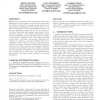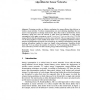976 search results - page 63 / 196 » Opportunity-Based Topology Control in Wireless Sensor Networ... |
124
click to vote
WINET
2011
14 years 6 months ago
2011
Sleep scheduling, which is putting some sensor nodes into sleep mode without harming network functionality, is a common method to reduce energy consumption in dense wireless sensor...
ISPDC
2010
IEEE
14 years 9 months ago
2010
IEEE
We propose a two layer protocol for tracking fast targets in sensor networks. At the lower layer, the Distributed Spanning Tree Algorithm (DSTA) [12] partitions the network into c...
109
click to vote
WSNA
2003
ACM
15 years 4 months ago
2003
ACM
Efficiently self organizing a network hierarchy with specific assignment of roles (or tasks) to sensors based on their physical wireless connectivity and sensing characteristics ...
130
click to vote
INFOCOM
2010
IEEE
14 years 10 months ago
2010
IEEE
Abstract—Wireless sensor networks (WSNs) are typically composed of low-cost sensors that are deeply integrated with physical environments. As a result, the sensing performance of...
113
click to vote
JUCS
2007
14 years 11 months ago
2007
: Clustering provides an effective mechanism for energy-efficient data delivery in wireless sensor networks. To reduce communication cost, most clustering algorithms rely on a sens...


